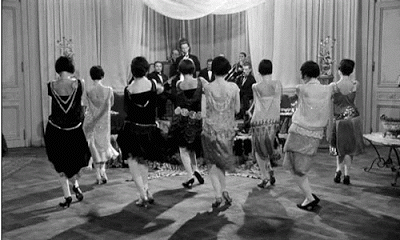This is an update of a blog I first posted 7 years ago, directed at buyers of vintage fashion. My next blog will be directed at sellers, about how to price vintage fashion.
Why does this 1950s dress cost $49, this one $98 and that one $300? Ever wondered why the big differences?
I am sometimes asked if I can accept an offer of a lower price for an item I have for sale, and I don’t like to just bluntly refuse without an explanation. Sometimes I’m asked how to price a vintage item, or why an item I’m selling is a certain price. This post is to explain a little about the vintage clothing and accessories marketplace and the pricing one sees.
First, you need to know how vintage clothing is acquired by those who present it for resale. With the exception of some one-shot Ebay sellers, it is infrequently something from the seller’s own closet or family’s closets. Very infrequently it was given to the seller.
Usually, vintage sellers who have been around any length of time must find and purchase vintage fashions. They may get up very early to get in line for promising estate sales, garage sales, car boot sales and flea markets. They may put ads out for purchasing vintage clothing and go on buying trips to nearby (or far away) cities and towns. They may regularly scour the thrift, second-hand and antique markets. Auctions can also be sources. The seller has to make many good contacts, persevere and be resourceful.
What impacts a price
✔️ Location. In some areas there may be relatively more or less vintage available, and at more or less high prices. Just to sustain the business may take more income in some areas than others.
✔️ Scarcity. Vintage clothing and accessories that pre-date the 1980s are hard to find in many areas, and the older, the scarcer. One of the most rare things of all the 20th century seems to be a beaded silk dress from the mid 1920s in excellent condition. The amount of activity (think dancing the Charleston) that some of these dresses endured in their Roaring 20s heyday took a toll, and the combination of the delicate fabric and heavy decoration has made these dresses extremely ephemeral. With the popularity of 1920s styles over the past few years, many seek these dresses and are truly amazed at the prices—but what’s really amazing is that there is an authentic beaded silk dress from the 1920s left to sell!
Some other scarcity issues involve sizes (such as larger shoe and dress sizes) and types of items (generally trousers are more worn out and disposed of than skirts, menswear more than womenswear, swimsuits can take a beating, as can shoes...).
✔️ Condition. The example of a 1950s dress for $49, $98 or $300 may come even from the same shop, with the $49 dress being pretty but flawed, the $98 a simple dress in excellent condition and the $300 dress pristine and with a good label and great design. Condition means so much in valuing vintage because it really impacts the wearability, life expectancy of the garment, and acceptability for various occasions. Would you want to attend your friend’s wedding in a dress with an obvious and unremovable stain on the front? No, but you might wear the dress to a swing dance.
✔️ Quality. There is a reason why vintage haute couture is haute priced: It is the work of a great designer, skillfully and beautifully crafted with techniques that are becoming rarer and rarer. The materials will match the workmanship and the overall impression will be, most likely, breathtaking.
Unlabeled items can also be of great quality, and a good seller will take the trouble to explain the elements of an item’s quality. It is important to know that certain designers, labels, styles, eras, fabrics and embellishments can justifiably command high prices. Even color influences price. Would you pay more for an aqua blue dress or a similar dress in brown?
✔️ The seller. If a seller has a great reputation, with excellent references and knowledge, he or she can charge more for an item. Some excellent sellers don’t charge at the top of the spectrum, but many do. They also will stand by their sales, something that is not easy to do with vintage, each item being unique. If you enjoy the offerings of particular sellers, and you know you can trust those sellers, their finds will probably be worth more to you.
✔️ The selling venue. Are you walking into a posh Manhattan vintage shop or an antique mall in a small town? Which do you think will need to charge more for that vintage handbag? Right.
The famous gown worn by Marilyn Monroe in 1962, and more recently by Kim Kardashian, unfortunately (White House photo by Cecil Stoughton. Wikimedia Commons)
✔️ Provenance. If an item was worn by Marilyn Monroe—such as the dress she wore singing Happy Birthday Mr. President, which sold at auction in 1999 for $1.3 million, and for $4.8 million in 2016—it is worth many times more than its weight in gold. Even if there is not a famous person tied to the vintage fashion item, a sweet or interesting story can push the value of the piece.
✔️ Going rates. Experienced vintage fashion sellers usually research before they price an item, working to find the right price for what they consider to be their place in the market, seeing how other sellers have priced. Sometimes a movie or show (Titanic, Mad Men and Downton Abbey immediately come to mind) will drive the interest in a style and the going rate will go up accordingly. Gem.app search helps immensely for checking prices on specific items for sale.
✔️ Work on the item. Some vintage items are ready to go as found, but usually they need washing or dry cleaning, often a bit of mending. In some cases a large amount of work goes into preparing a vintage garment or accessory for use. Some items are definitely worth the time, like one of those rare 1920s beaded silk dresses—if they are damaged but reparable, the repairs are often worthwhile for bringing such a beautiful piece of history back to life. Of course excellent work takes knowledge, skill and time.
✔️ Desirability. This is kind of a catch-all that overlaps the quality, scarcity, selling venue, seller—everything. Sometimes there is a certain je ne sais quoi about how the item is presented that makes it—and the seller—hot stuff. The same item may be almost worthless in other hands.
Do all these add up to a formula for how much that 1950s dress should cost? No, not at all. Pricing changes every day and it is nebulous. Even the best sellers make miscalculations in pricing, and the least experienced seller may earn top money on a particular item. Desirability may make an item of low quality into the coolest and most valuable thing in the shop for some people. The best shop owner may have prices so low that you wonder if the item is of any quality. There are simply no hard and fast rules about pricing.
Then there is the thrift shop purchase. You know, the one where you found a designer dress from the 1950s in top condition and half off of $7.50? Almost everyone who has ever loved the thrill of the hunt has a story to tell of some incredible deal. This has the effect of making the general public think that all one needs is a bit of pocket change and a trip to the thrift. Of course finding something great and vintage for next to nothing is rare and getting rarer, so if you fancy items that predate the 1980s, you will mostly come up empty.
There may also be the perception that a vintage seller doesn’t do anything but buy, mark up the price and resell. Some might do no more than that, but those who take the business seriously do lots more. For instance, I do a lot of research and stay in close touch with colleagues at the Vintage Fashion Guild who can help me when I don’t know something about a vintage piece. I have bookshelves full of vintage fashion history books. I did so much research on fabric that I ended up volunteering to write and compile the VFG’s Fabric Resource. Over the course of years I’ve built up many contacts and quite a lot of knowledge.
In my house there are always buckets of vintage items soaking, needles with every color of thread stuck in a pincushion, bags of metal zippers, jars of vintage buttons. I have a careful dry cleaner that I trust and a skilled seamstress for things I can’t fix myself. I have a storage cabinet full of various stain removers, gentle washes and odor lifters. Not only do I read and write blogs about vintage fashion, I participate in the conversations about it on the Vintage Fashion Guild forums, Facebook, Twitter, Instagram and Pinterest. I even wrote a book about it: Wear Vintage Now! Choose It, Care for It, Style It Your Way. In my selling practices I am as careful and honest as I can be. I am passionate about what I do. I sincerely care about each individual who crosses my vintage path. And I am not alone in any of this—there are quite a few really excellent vintage fashion shops. Is what we do more than buying and reselling? I think so.
Bottom line? There’s no magic formula for pricing vintage, but these are some of the considerations that might be taken into account.





